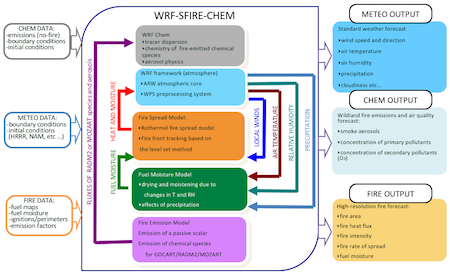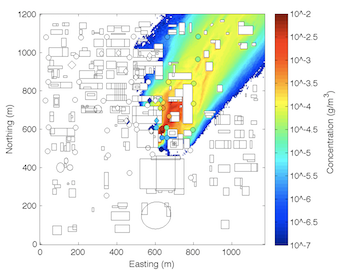Kochanski A. K., Herron-Thorpe F., Mallia D. V., Mandel J., Vaughan J. K. (2021). Integration of a Coupled Fire-Atmosphere Model Into a Regional Air Quality Forecasting System for Wildfire Events, Frontiers in Forests and Global Change, 2021, 4, 167, DOI=10.3389/ffgc.2021.728726.
Mandal A, Nykiel G, Strzyzewski T., Kochanski A., Wrońska W, Gruszczyńska M, Figurski M. (2021). High resolution fire danger forecast for Poland based on Weather Research and Forecasting Model, International Journal of Wildland Fire, Accepted.
M. Halubok, A. K. Kochanski, R. Stoll and B. N. Bailey (2021). Errors in the estimation of leaf area density from aerial LiDAR data: Influence of statistical sampling and heterogeneity, IEEE Transactions on Geoscience and Remote Sensing, doi: 10.1109/TGRS.2021.3123585.
Farguell, A.; Mandel, J.; Haley, J.; Mallia, D.V.; Kochanski, A.; Hilburn, K. Machine Learning Estimation of Fire Arrival Time from Level-2 Active Fires Satellite Data. Remote Sens. 2021, 13, 2203. https://doi.org/10.3390/rs13112203
Su, J.-Y.; Goel, R.; Burian, S.; Hinners, S.J.; Kochanski, A.; Strong, C.; Barber, M.E. Water Quality Trading Framework with Uncertainty for River Systems Due to Climate and Population Characteristics. Water 2021, 13, 1738. https://doi.org/10.3390/w13131738
Riley, C.; Rupper, S.; Steenburgh, J.W.; Strong, C.; Kochanski, A.K.; Wolvin, S. Characteristics of Historical Precipitation in High Mountain Asia Based on a 15-Year High Resolution Dynamical Downscaling. Atmosphere 2021, 12, 355. https://doi.org/10.3390/atmos12030355
Mallia D.V; Kochanski A.K., Kelly K.E., Whitaker R., Xing W., Mitchell L., Jacques A., Farguell A., Mandel J., Gaillardon P-E, Becnel T., Krueger S. (2020) Evaluating wildfire smoke transport within a coupled fire-atmosphere model using a high-density observation network for an episodic smoke event along Utah's Wasatch Front. Journal of Geophysical Research Atmosphere, 125, e2020JD032712 https://doi.org/10.1029/2020JD032712
Mallia, D.V.; Kochanski, A.K.; Urbanski, S.P.; Mandel, J.; Farguell, A.; Krueger, S.K. Incorporating a Canopy Parameterization within a Coupled Fire-Atmosphere Model to Improve a Smoke Simulation for a Prescribed Burn. Atmosphere 2020, 11, 832.https://www.mdpi.com/2073-4433/11/8/832/htm
Herr V., Kochanski A. K. , Miller V. V., McCrea R., O'Brien D., Mandel J.(2020) A method for estimating the socioeconomic impact of Earth observations in wildland fire suppression decisions. International Journal of Wildland Fire 29, 282-293. https://doi.org/10.1071/WF18237
Hasan M, Strong C, Kochanski A, Burian S, Barber M, 2020. Validating dynamically downscaled climate projections for mountainous watersheds using historical runoff data coupled with the Distributed Hydrologic Soil Vegetation Model (DHSVM), Water, doi:10.3390/w12051389.
Kochanski, A. K., Mallia, D. V., Fearon, M. G., Mandel, J., Souri, A. H., & Brown, T. ( 2019). Modeling wildfire smoke feedback mechanisms using a coupled fire-atmosphere model with a radiatively active aerosol scheme. Journal of Geophysical Research: Atmospheres, 124. https://doi.org/10.1029/2019JD030558
K.B. Khatri C. Strong N. von Stackelberg M. Buchert A.K. Kochanski (2019). Impact of Climate and Land Use Change on Streamflow and Sediment Yield in a Snow-Dominated Semiarid Mountainous Watershed. JAWRA Journal of the American Water Resources AssociationVolume 55, Issue 6 DOI:10.1111/1752-1688.12803
Liu Y., Kochanski A., Kirk B. R., Mell W., Linn R., Paugam R., Mandel J., Fournier A., Jenkins M., Goodrick S., Achtemeier G., Zhao F., Ottmar R., French N. , Larkin N., Brown T., Hudak A., Dickinson M., Potter B., Clements C., Urbanski S., Prichard S., Watts A., McNamara Derek (2019) Fire behaviour and smoke modelling: model improvement and measurement needs for next-generation smoke research and forecasting systems. International Journal of Wildland Fire 28, 570-588. https://doi.org/10.1071/WF18204
Clements, C. B., A. K. Kochanski, D. Seto, B. Davis, C. Camacho, N. P. Lareau, J. Contezac, W. E. Heilman, S. K. Krueger, B. Butler, J. Restaino, R. D. Ottmar, R. Vihnanek, J. Flynn, Jean-Baptiste Filippi, T. Barboni, D. E. Hall, J. Mandel, M. A. Jenkins, and J. O'Brien, B. Hornsby, and C. Teske, (2019) The FireFlux II Experiment: A model-guided field experiment to understand fire-atmosphere interactions and fire spread International Journal of Wildland Fire. https://www.publish.csiro.au/WF/WF18089
Prichard S., N. Larkin, Roger Ottmar, Nancy French, Kirk Baker, Tim Brown, Craig Clements, Matt Dickinson, Andrew Hudak, Adam Kochanski, Rod Linn, Yongqiang Liu, Brian Potter, William Mell, Danielle Tanzer, Shawn Urbanski, Adam Watts, (2019) The Fire and Smoke Model Evaluation Experiment - A Plan for Integrated, Large Fire-Atmosphere Field Campaigns. Atmosphere 2019, 10(2), 66; https://doi.org/10.3390/atmos10020066
Arunchandra S. Chandra, Paquita Zuidema, Steven Krueger, Adam Kochanski, Simon P. de Szoeke and Jianhao Zhang (2018) Moisture distributions in tropical cold pools from equatorial Indian Ocean observations and cloud-resolving simulations. Journal of Geophysical Research doi: 10.1029/2018jd028634
Kochanski A.K, A. Fournier and J. Mandel (2018). Experimental Design of a Prescribed Burn Instrumentation. Atmosphere 2018, 9(8), 296; https://doi.org/10.3390/atmos9080296
Mallia, D.V.; Kochanski, A.K.; Urbanski, S.P.; Lin, J.C. Optimizing Smoke and Plume Rise Modeling Approaches at Local Scales. Atmosphere 2018, 9, 166.
Krishna B. Khatri, Courtenay Strong, Adam K. Kochanski., Steven Burian, Craig Miller, Candice Hasenyager (2018), Water Resources Criticality Due to Future Climate Change and Population Growth: Case of River Basins in Utah, USA Journal of Water Resources Planning and Management DOI 10.1061/(ASCE)WR.1943-5452.00009
Souri, A. H., Choi, Y., Jeon, W., Kochanski, A. K., Diao, L., Mandel, J., Bhave, P. V., & Pan, S. (2017). Quantifying the impact of biomass burning emissions on major inorganic aerosols and their precursors in the U.S. Journal of Geophysical Research: Atmospheres, 122. https://doi.org/10.1061/(ASCE)WR.1943-5452.0000959
Mallia, D. V., A. Kochanski, C. Pennell, W. Oswald, and J. C. Lin, (2017) Wind-blown dust modeling using a backward Lagrangian particle dispersion model. J. Appl. Meteor. Climate., 56, 2845-2867.
Strong C, Khatri K, Kochanski A., Lewis C, Allen N. (2017). Reference evapotranspiration from coarse-scale and dynamically downscaled data in complex terrain: sensitivity to interpolation and resolution, Journal of Hydrology, odi: 10.1016/j.hydrol.2017.02.045.
Scalzitti J, Strong C, Kochanski A, (2016). Climate change impact on the roles of temperature and precipitation in western U.S. snowpack variability, Geophysical Research Letters doi:10.1002/2016GL068798
Scalzitti J, Strong C, Kochanski A, (2016). A 26 year high-resolution dynamical downscaling over the Wasatch Mountains: Synoptic effects on winter precipitation performance, Journal of Geophysical Research, doi: 10.1002/2015JD024497
Kochanski A. K., E. R. Pardyjak, R. Stoll, A. Gowardhan, M.J Brown, W.J. Steenburgh (2015) One-Way Coupling of the WRF - QUIC Urban Dispersion Modeling System Journal of Applied Meteorology And Climatology DOI: 10.1175/JAMC-D-15-0020.1
Kochanski A. K., Jenkins M.A., Yedinak K., Mandel J., Beezley J, and Lamb B. (2015) Toward an integrated system for fire, smoke and air quality simulations, International Journal of Wildland Fire - http://dx.doi.org/10.1071/WF14074
Vejmelka M, Kochanski A, Mandel J, (2015) Data assimilation of dead fuel moisture observations from remote automated weather stations, International Journal of Wildland Fire 25, 558-568. http://dx.doi.org/10.1071/WF14085
Strong C., A. K. Kochanski, E.T. Crosman (2014) A slab model of the Great Salt Lake for regional climate simulation J. Adv. Model. Earth Syst., 6, 602-615, doi:10.1002/2014MS000305.
Mandel, J., Amram, S., Beezley J. D., Kelman G., Kochanski A. K., Kondratenko V. Y., Lynn, B. H., Regev, B., and Vejmelka, M. (2014): Recent advances and applications of WRF-SFIRE, Nat. Hazards Earth Syst. Sci., 14, 2829-2845, doi:10.5194/nhess-14-2829-2014, 2014.
Kochanski, A. K., Jenkins M. A., Mandel J, Beezley J. D. and Krueger S. K., (2013): Evaluation of WRF-Sfire Performance with Field Observations from the FireFlux experiment. Geoscientific Model Development 6, 1109-1126, 2013 doi:10.5194/gmd-6-1109-2013
Kochanski A. K., Jenkins M.A., Krueger S. K., Mandel J., and Beezley J. D., (2013): Real time simulation of 2007 Santa Ana fires, Forest Ecology and Management 15, 136-149, 2013 doi:10.1016/j.foreco.2012.12.014
Kochanski, A. K., Jenkins M. A., Sun R., Krueger S. K., and Charney J. J., (2013): The importance of low-level environmental vertical wind shear to wildfire propagation: Proof of concept, Journal of Geophysical Research 118(15) 8238-8252 DOI: 10.1002/jgrd.50436.
Mandel J.,J. D. Beezley, Kochanski A. K., Kondratenko V. Y., Kim M. (2012): Assimilation of Perimeter Data and Coupling with Fuel Moisture in a Wildland Fire–Atmosphere DDDAS. Procedia Computer Science, Volume 9, 2012, Pages 1100-1109, https://doi.org/10.1016/j.procs.2012.04.119
Mandel J., J. D. Beezley, and A. K. Kochanski (2011): Coupled atmosphere-wildland fire modeling with WRF-Fire version 3.3, Geoscientific Model Development, 4, 591-610, doi:10.5194/gmd-4-591-2011
Jordanov, G., J. D. Beezley, N. Dobrinkova, A. K. Kochanski, and J. Mandel, (2011) Simulation by WRF-Fire of the 2009 Harmanli fire (Bulgaria) Large-Scale Scientific Computing, Lecture Notes in Computer Science Volume 7116, 2012, pp 291-298.
Kahn B. H., J. Teixeira1, E. J. Fetzer, A. Gettelman, S. M. Hristova-Veleva, X. Huang, A. K. Kochanski, M. Kohler, S. K. Krueger, R. Wood, and M. Zhao: (2011) Temperature and water vapor variance scaling in global models: Comparisons to satellite and aircraft data. J. Atmos. Sci., 68(9), 2156-2168.
Kochanski, A. K., Koracin D., Dorman C. (2006) Comparison of the wind stress algorithms and their influence on the wind stress using buoy measurement over the shelf of Bodega Bay, California. Deep Deep-Sea Research II 53, 2865-2886
Wind Stress Curl and Upwelling along the California Coast, Koracin, D., Kochanski A., Dorman, C.E., Dever, E.P Bulletin of the American Meteorological Society, Volume 86, number 5, May 2005, pages 629-630.







